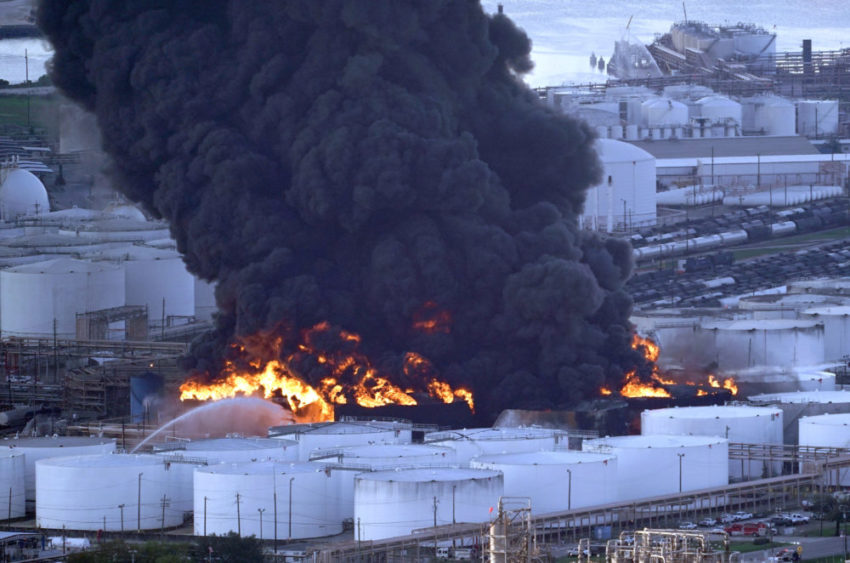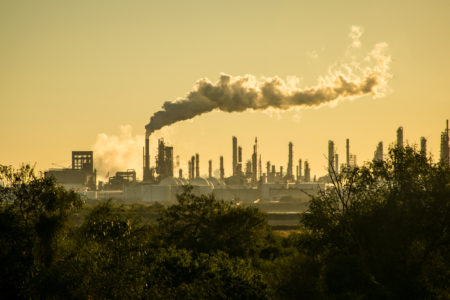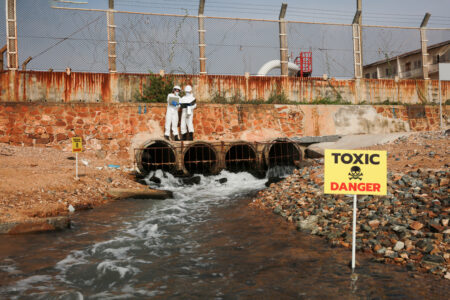
Share On Social!
Last month, a massive cloud of black smoke covered Houston (44.5% Latino), subjecting its residents to noxious fumes and harmful pollution exposure.
The fire, which burned for three days, began after an explosion at the petrochemical storage facility Intercontinental Terminals Co.
While air quality was determined to be moderately safe by the Texas Commission on Environmental Quality in the days following the explosion, Houstonians could face long-term impacts from the chemicals released into the atmosphere.
“I’ve seen ash fall out — black pieces of ash,” Jorge Guerra, who lives three miles from the site, told CBS News. “I’ve seen it on my cars, I’ve seen it on the front porch on the sidewalk. Does that scare you? It does, it does. What scares me more is what we don’t see.”
Chemical Plant Fires
Houston is referred to by some as America’s petrochemical capital. That kind of industry power has played a part in making the city a national powerhouse.

It’s also been the cause of exposing Texans to chemicals in the air they breathe, from fires that can occur, on average, once every six weeks, according to the Houston Chronicle.
Some might think that these kinds of fires come with the risks of being in the petrochemical business. Elena Craft, senior director for health and climate at Environmental Defense Fund, disagrees with that sentiment.
“That is simply not true. Chemical fires and explosions are largely preventable. So why do they continue to happen?” Craft wrote in an op-ed for the Chronicle. “It is because the state agency responsible for ensuring chemical plant safety is missing in action — unable or unwilling to protect the health and well-being of Texas families.”
A significant issue with fires like these is the substances in the smoke that is entering the atmosphere and water. The main chemical of concern, benzene, is known to cause cancer in those who face long-term exposure.
The Deer Park blaze represents larger issues as well, including health equity disparities amongst the race populations.
Impacting Houston Latinos
As previously reported, Latinos are impacted by air pollution at significantly higher rates than their white peers. This is no different in Houston.
The metropolitan Houston area has one of the highest Latino populations in the country, according to Pew Research Center.
When looking at the breakdown of the area by race and income, between Houston and two of its large suburbs, The Woodlands and Sugar Land, a significant gap is present.
Houston
- Roughly 18 miles from Deer Park
- Total population: 2,312,717
- Latino Population: 44.5%
- White Population: 58.5%
- Median Household Income: $49,399
- Poverty Rate: 21.2%
The Woodlands
- Roughly 45 miles from Deer Park

- Total population: 117,305
- Latino Population: 16.4%
- White Population: 85.9%
- Median Household Income: $115,083
- Poverty Rate: 4.1%
Sugar Land
- Roughly 30 miles from Deer Park
- Total population: 88,485
- Latino Population: 9.6%
- White Population: 50.1%
- Median Household Income: $108,994
- Poverty Rate: 6%
Consistent with available data, it can be understood that poorer minorities experience higher levels of exposure from these fires than those in wealthier suburbs, which are further away from the immediate dangers.
Risks from Exposure
Contact with Benzene contains many short-term and long-term impacts. 
One main issue that arises from exposure is the way this substance disrupts bodily function, according to the CDC.
“Benzene works by causing cells not to work correctly,” the CDC writes. “For example, it can cause bone marrow not to produce enough red blood cells, which can lead to anemia. Also, it can damage the immune system by changing blood levels of antibodies and causing the loss of white blood cells.”
They also state side effects will depend on the amount of time exposed, age, preexisting conditions, and other health factors.
Still, the Deer Park fire came days after a similar blaze at Exxon Mobile’s Baytown facility.
Texas legislators need to step up by passing stronger regulations and making better plans to help reduce the number of incidences and the harm they cause, according to Craft.
“[State lawmakers] can make risk management plans readily available so emergency responders and the public have specific information on potential hazards at chemical facilities,” Craft writes. “They can close the loophole that allows industry to avoid penalties for unauthorized pollution releases. They can create a uniform toxic alert system because people must be aware of the risks to their health and safety in a timely manner. They can resist the industry push to make it even easier to obtain permits.
“Hopefully, then the madness can stop.”
Editor’s Notes:
- The featured image used in this article comes from the Houston Chronicle, taken by Original caption: Firefighters battle a petrochemical fire at the Intercontinental Terminals Company Monday, March 18, 2019, in Deer Park, Texas. The large fire at a Houston-area petrochemicals terminal will likely burn for another two days, authorities said Monday, noting that air quality around the facility was testing within normal guidelines.
- This article is part of a collaboration between Salud America! and the Hoffman Toxicant-Induced Loss of Tolerance (TILT) program at UT Health- San Antonio. To find out if you are TILTed due to exposure to everyday foods, chemicals, or drugs, take a self-assessment or learn more about TILT.
By The Numbers
1
Quick Survey
Can help you find out how chemically sensitive you are



